Note: All links below go to external pages.
Books by Current Faculty
The Paris Commune: A Brief History
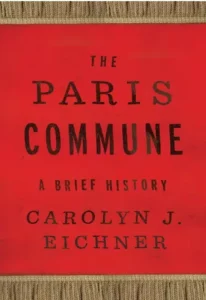
Carolyn J. Eichner
At dawn on March 18, 1871, Parisian women stepped between cannons and French soldiers, using their bodies to block the army from taking the artillery from their working-class neighborhood. When ordered to fire, the troops refused and instead turned and arrested their leaders. Thus began the Paris Commune, France’s revolutionary civil war that rocked the nineteenth century and shaped the twentieth. Considered a golden moment of hope and potential by the left, and a black hour of terrifying power inversions by the right, the Commune occupies a critical position in understanding modern history and politics. A 72-day conflict that ended with the ferocious slaughter of Parisians, the Commune represents for some the final insurgent burst of the French Revolution’s long wake, for others the first “successful” socialist uprising, and for yet others an archetype for egalitarian socio-economic, feminist, and political change. Militants have referenced and incorporated its ideas into insurrections across the globe, throughout the twentieth and into the twenty-first centuries, keeping alive the revolution’s now-iconic goals and images. Innumerable scholars in countless languages have examined aspects of the 1871 uprising, taking perspectives ranging from glorifying to damning this world-shaking event. The Commune stands as a critical and pivotal moment in nineteenth-century history, as the linchpin between revolutionary pasts and futures, and as the crucible allowing glimpses of alternate possibilities. Upending hierarchies of class, religion, and gender, the Commune emerged as a touchstone for the subsequent century-and-a-half of revolutionary and radical social movements. Rutgers Press
The Holiday Makers

Richard K. Popp
In mid-twentieth-century America, mass tourism became emblematic of the expanding horizons associated with an affluent, industrial society. Nowhere was the image of leisurely travel more visible than in the parade of glossy articles and advertisements that beckoned readers from the pages of popular magazines. In Richard K. Popp’s The Holiday Makers, the magazine industry serves as a window into postwar media and consumer society, showing how the dynamics of market research and commercial print culture helped shape ideas about place, mobility, and leisure. LSU Press
Feminism’s Empire
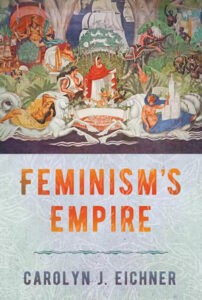
Carolyn J. Eichner
Feminism’s Empire investigates the complex relationships between imperialisms and feminisms in the late nineteenth century and demonstrates the challenge of conceptualizing “pro-imperialist” and “anti-imperialist” as binary positions. By intellectually and spatially tracing the era’s first French feminists’ engagement with empire, Carolyn J. Eichner explores how feminists opposed—yet employed—approaches to empire in writing, speaking, and publishing. In differing ways, they ultimately tied forms of imperialism to gender liberation.
Among the era’s first anti-imperialists, French feminists were enmeshed in the hierarchies and epistemologies of empire. They likened their gender-based marginalization to imperialist oppressions. Imperialism and colonialism’s gendered and sexualized racial hierarchies established categories of inclusion and exclusion that rested in both universalism and ideas of “nature” that presented colonized people with theoretical, yet impossible, paths to integration. Feminists faced similar barriers to full incorporation due to the gendered contradictions inherent in universalism. The system presumed citizenship to be male and thus positioned women as outsiders. Feminism’s Empire connects this critical struggle to hierarchical power shifts in racial and national status that created uneasy linkages between French feminists and imperial authorities. Cornell University Press
The Fante and the Transatlantic Slave Trade
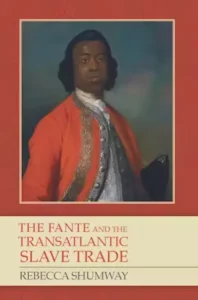
Rebecca Shumway
The history of Ghana attracts popular interest out of proportion to its small size and marginal importance to the global economy. Ghana is the land of Kwame Nkrumah and the Pan-Africanist movement of the 1960s; it has been a temporary home to famous African Americans like W. E. B. DuBois and Maya Angelou; and its Asante Kingdom and signature kente cloth-global symbols of African culture and pride-are well known. Ghana also attracts a continuous flow of international tourists because of two historical sites that are among the most notorious monuments of the transatlantic slave trade: Cape Coast and Elmina Castles. These looming structures are a vivid reminder of the horrific trade that gave birth to the black population of the Americas.
The Fante and the Transatlantic Slave Trade explores the fascinating history of the transatlantic slave trade on Ghana’s coast between 1700 and 1807. Here author Rebecca Shumway brings to life the survival experiences of southern Ghanaians as they became both victims of continuous violence and successful brokers of enslaved human beings. The era of the slave trade gave birth to a new culture in this part of West Africa, just as it was giving birth to new cultures across the Americas. The Fante and the Transatlantic Slave Trade pushes Asante scholarship to the forefront of African diaspora and Atlantic World studies by showing the integral role of Fante middlemen and transatlantic trade in the development of the Asante economy prior to 1807. Boydell and Brewer
Slavery and its Legacy in Ghana and the Diaspora

Rebecca Shumway
Ghana-for all its notable strides toward more egalitarian political and social systems in the past 60 years-remains a nation plagued with inequalities stemming from its long history of slavery and slave trading. The work assembled in this collection explores the history of slavery in Ghana and its legacy for both Ghana and the descendants of people sold as slaves from the “Gold Coast” in the era of the transatlantic slave trade.
The volume is structured to reflect four overlapping areas of investigation: the changing nature of slavery in Ghana, including the ways in which enslaved people have been integrated into or excluded from kinship systems, social institutions, politics, and the workforce over time; the long-standing connections forged between Ghana and the Americas and Europe through the transatlantic trading system and the forced migration of enslaved people; the development of indigenous and transnational anti-slavery ideologies; and the legacy of slavery and its ongoing reverberations in Ghanaian and diasporic society.
Bringing together key scholars from Ghana, Europe and the USA who introduce new sources, frames and methodologies including heritage, gender, critical race, and culture studies, and drawing on archival documents and oral histories, Slavery and Its Legacy in Ghana and the Diaspora will be of great interest to scholars and students of comparative slavery, abolition and West African history. Bloomsbury
Memory, Reconciliation, and Reunions in South Korea: Crossing the Divide
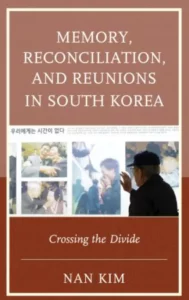
Nan Kim
Drawing on reinterpretations of melancholia and collective remembrance, Memory, Reconciliation, and Reunions in South Korea: Crossing the Divide explores the multi-layered implications of divided Korea’s liminality, or its perceived “in-betweenness” in space and time. Offering a timely reconsideration of the pivotal period following the inter-Korean Summit of June 2000, this book focuses on a series of emotionally charged meetings among family members who had lost all contact for over fifty years on opposite sides of the Korean divide. With the scope of its analysis ranging from regional geopolitics and watershed political rituals to everyday social dynamics and intimate family narratives, this study provides a lens for approaching the cultural process of moving from a disposition of enmity to one of recognition and engagement amid the complex legacies of civil war and the global Cold War on the Korean Peninsula. Rowman and Littlefield
Claiming Place: On the Agency of Hmong Women
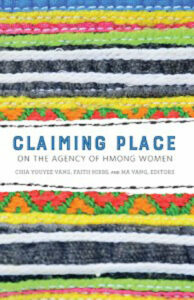
Editors: Chia Youyee Vang, Faith Nibbs, and Ma Vang, Afterword by Cathy J. Schlund-Vials
A field-defining book that illustrates how Hmong scholarship might progress
Claiming Place expands knowledge about the Hmong lived reality while contributing to broader conversations on sexuality, diaspora, and agency. This book argues that Hmong women are active agents in challenging oppressive societal practices and in creating alternative forms of belonging. University of Minnesota Press
Elephant Trails: A History of Animals and Culture
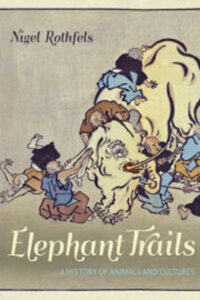
Nigel Rothfels
Why have elephants—and our preconceptions about them—been central to so much of human thought? From prehistoric cave drawings in Europe and ancient rock art in Africa and India to burning pyres of confiscated tusks, our thoughts about elephants tell a story of human history. In Elephant Trails, Nigel Rothfels argues that, over millennia, we have made elephants into both monsters and miracles as ways to understand them but also as ways to understand ourselves. Drawing on a broad range of sources, including municipal documents, zoo records, museum collections, and encounters with people who have lived with elephants, Rothfels seeks out the origins of our contemporary ideas about an animal that has been central to so much of human thought. He explains how notions that have been associated with elephants for centuries—that they are exceptionally wise, deeply emotional, and have a special understanding of death; that they never forget, are beloved of the gods, and suffer unusually in captivity; and even that they are afraid of mice—all tell part of the story of these amazing beings. Exploring the history of a skull in a museum, a photograph of an elephant walking through the American South in the early twentieth century, the debate about the quality of life of a famous elephant in a zoo, and the accounts of elephant hunters, Rothfels demonstrates that elephants are not what we think they are—and they never have been. Elephant Trails is a compelling portrait of what the author terms “our elephant.” Project Muse
A New History of Modern Computing

Thomas Haigh and Paul E. Ceruzzi
How the computer became universal.
Over the past fifty years, the computer has been transformed from a hulking scientific super tool and data processing workhorse, remote from the experiences of ordinary people, to a diverse family of devices that billions rely on to play games, shop, stream music and movies, communicate, and count their steps. In A New History of Modern Computing, Thomas Haigh and Paul Ceruzzi trace these changes. A comprehensive reimagining of Ceruzzi’s A History of Modern Computing, this new volume uses each chapter to recount one such transformation, describing how a particular community of users and producers remade the computer into something new.
Haigh and Ceruzzi ground their accounts of these computing revolutions in the longer and deeper history of computing technology. They begin with the story of the 1945 ENIAC computer, which introduced the vocabulary of “programs” and “programming,” and proceed through email, pocket calculators, personal computers, the World Wide Web, videogames, smart phones, and our current world of computers everywhere—in phones, cars, appliances, watches, and more. Finally, they consider the Tesla Model S as an object that simultaneously embodies many strands of computing. MIT Press
Prisoner of Wars: A Hmong Fighter Pilot’s Story of Escaping Death and Confronting Life

Chia Youyee Vang, with Pao Yang, Retired Captain, U.S. Secret War in Laos, 2020
Retired Captain Pao Yang was a Hmong airman trained by the U.S. Air Force and CIA to fly T-28D aircraft for the U.S. Secret War in Laos. However, his plane was shot down during a mission in June 1972. Yang survived, but enemy forces captured him and sent him to a POW camp in northeastern Laos. He remained imprisoned for four years after the United States withdrew from Vietnam because he fought on the American side of the war.
Prisoner of Wars shows the impact the U.S. Secret War in Laos had on Hmong combatants and their families. Chia Vang uses oral histories that poignantly recount Yang’s story and the deeply personal struggles his loved ones—who feared he had died—experienced in both Southeast Asia and the United States. As Yang eventually rebuilt his life in America, he grappled with issues of freedom and trauma.
Yang’s life provides a unique lens through which to better understand the lasting impact of the wars in Southeast Asia and the diverse journeys that migrants from Asia made over the last two centuries. Prisoner of Wars makes visible an aspect of the collateral damage that has been left out of dominant Vietnam War narratives. Temple University Press
Fly Until You Die: An Oral History of Hmong Pilots in the Vietnam War

Chia Youyee Vang, 2019
The Vietnam War is the subject of hundreds of scholarly studies, policy reports, memoirs, and literary titles. As America’s longest and most controversial war, it coincided with domestic turmoil in the United States and in Southeast Asia, led to the displacement of large numbers of people, and strained the social fabric of Cambodian, Lao, and Vietnamese societies. The complex nature of the war means that despite the many books that have been written about it, much remains to unfold, in particular the experiences of ethnic minorities in Laos who became entangled in Cold War politics during the 1960s and 1970s. This book fills the gap by exploring the dramatic forces of history that drew several dozen young Hmong men to become fighter pilots in the United States’ Secret War in Laos, which was in direct support of the larger war in Vietnam. They transformed from ethnic minorities who mostly lived on the margins of Lao society to daring airmen working alongside American pilots. After four decades in exile, surviving pilots, families of those killed in action, and American veterans who worked with them collectively narrated their version of the historical events that resulted in the forced migration of nearly 150,000 Hmong to the United States. By privileging Hmong knowledge, this book begs us to reconsider the war from overlooked perspectives and to engage in the ongoing construction of meanings of war and postwar memories in shaping ethnic and national identities. Temple University Press
Exploring the Early Digital
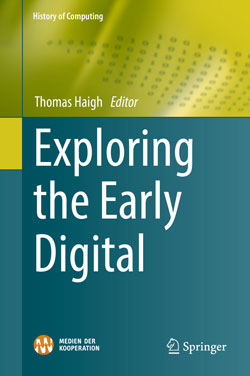
Edited by Thomas Haigh. Springer, 2019.
Changes in the present challenge us to reinterpret the past, but historians have not yet come to grips with the convergence of computing, media, and communications technology. Today these things are inextricably intertwined, in technologies such as the smartphone and internet, in convergent industries, and in social practices. Yet they remain three distinct historical subfields, tilled by different groups of scholars using different tools. We often call this conglomeration “the digital,” recognizing its deep connection to the technology of digital computing. Unfortunately, interdisciplinary studies of digital practices, digital methods, or digital humanities have rarely been informed by deep engagement with the history of computing. Contributors to this volume have come together to reexamine an apparently familiar era in the history of computing through new lenses, exploring early digital computing and engineering practice as digital phenomena rather than as engines of mathematics and logic. Most focus on the period 1945 to 1960, the era in which the first electronic digital computers were created and the computer industry began to develop. Because digitality is first and foremost a way of reading objects and encoding information within them, we are foregrounding topics that have until now been viewed as peripheral in the history of computing: betting odds calculators, card file systems, program and data storage, programmable calculators, and digital circuit design practices. Reconceptualizing the “history of computing” as study of the “early digital” decenters the stored program computer, repositioning it as one of many digital technologies. https://early.digital/
ENIAC In Action: Making and Remaking the Modern Computer
Thomas Haigh, Mark Priestley & Crispin Rope. MIT, 2016. Also in Japanese, Kyoritsu Shuppan, 2016.


Conceived in 1943, completed in 1945, and decommissioned in 1955, ENIAC (the Electronic Numerical Integrator and Computer) was the first general-purpose programmable electronic computer. But ENIAC was more than just a milestone on the road to the modern computer. During its decade of operational life, ENIAC calculated sines and cosines and tested for statistical outliers, plotted the trajectories of bombs and shells, and ran the first numerical weather simulations. ENIAC in Action tells the whole story for the first time, from ENIAC’s design, construction, testing, and use to its afterlife as part of computing folklore. It highlights the complex relationship of ENIAC and its designers to the revolutionary approaches to computer architecture and coding first documented by John von Neumann in 1945. Within this broad sweep, the authors emphasize the crucial but previously neglected years of 1947 to 1948, when ENIAC was reconfigured to run what the authors claim was the first modern computer program to be executed: a simulation of atomic fission for Los Alamos researchers. The authors view ENIAC from diverse perspectives—as a machine of war, as the “first computer,” as a material artifact constantly remade by its users, and as a subject of (contradictory) historical narratives. They integrate the history of the machine and its applications, describing the mathematicians, scientists, and engineers who proposed and designed ENIAC as well as the men—and particularly the women who—built, programmed, and operated it. https://www.eniacinaction.com/
Histories of Computing

Michael S. Mahoney, edited and with an introduction by Thomas Haigh. Harvard, 2011.
Computer technology is pervasive in the modern world, its role ever more important as it becomes embedded in a myriad of physical systems and disciplinary ways of thinking. The late Michael Sean Mahoney was a pioneer scholar of the history of computing, one of the first established historians of science to take seriously the challenges and opportunities posed by information technology to our understanding of the twentieth century. Mahoney’s work ranged widely, from logic and the theory of computation to the development of software and applications as craft-work. But it was always informed by a unique perspective derived from his distinguished work on the history of medieval mathematics and experimental practice during the Scientific Revolution. His writings offered a new angle on very recent events and ideas and bridged the gaps between academic historians and computer scientists. Indeed, he came to believe that the field was irreducibly pluralistic and that there could be only histories of computing. In this collection, Thomas Haigh presents thirteen of Mahoney’s essays and papers organized across three categories: historiography, software engineering, and theoretical computer science. His introduction surveys Mahoney’s work to trace the development of key themes, illuminate connections among different areas of his research, and put his contributions into context. The result is a landmark work, of interest to computer professionals as well as historians of technology and science. Amazon
A is for Asylum Seeker: Words for People on the Move / A de Asilo: Palabras Para Personas en Movimiento
A clear and concise A-to-Z of keywords that echo our current human rights crisis

As millions are forced to leave their nations of origin as a result of political, economic, and environmental peril, rising racism and xenophobia have led to increasingly harsh policies. A mass-mediated political circus obscures both histories of migration and longstanding definitions of words for people on the move, fomenting widespread linguistic confusion. Under this circus tent, there is no regard for history, legal advocacy, or jurisprudence. Yet in a world where the differences between “undocumented migrant” and “asylum seeker” can mean life or death, words have weighty consequences. Read more. (Fordham University Press, 2016)
Chicago’s Block Clubs: How Neighbors Shape the City

What do you do if your alley is strewn with garbage after the sanitation truck comes through? Or if you’re tired of the rowdy teenagers next door keeping you up all night? Is there a vacant lot on your block accumulating weeds, needles, and litter? For a century, Chicagoans have joined block clubs to address problems like these that make daily life in the city a nuisance. When neighbors work together in block clubs, playgrounds get built, local crime is monitored, streets are cleaned up, and every summer is marked by the festivities of day-long block parties.
In Chicago’s Block Clubs, Amanda I. Seligman uncovers the history of the block club in Chicago—from its origins in the Urban League in the early 1900s through to the Chicago Police Department’s twenty-first-century community policing program. Recognizing that many neighborhood problems are too big for one resident to handle—but too small for the city to keep up with—city residents have for more than a century created clubs to establish and maintain their neighborhood’s particular social dynamics, quality of life, and appearance. Omnipresent yet evanescent, block clubs are sometimes the major outlets for community organizing in the city—especially in neighborhoods otherwise lacking in political strength and clout. Drawing on the stories of hundreds of these groups from across the city, Seligman vividly illustrates what neighbors can—and cannot—accomplish when they work together. (University of Chicago Press, 2016)
Between Truth and Time: A History of Soviet Central Television
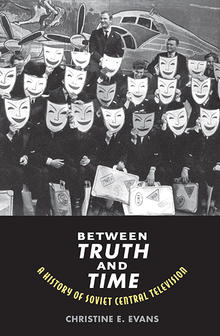
In the first full-length study of Soviet Central Television to draw extensively on archival sources, interviews, and television recordings, Christine E. Evans (UWM historian and associate professor) challenges the idea that Soviet mass culture in the Brezhnev era was dull and formulaic. Tracing the emergence of play, conflict, and competition on Soviet news programs, serial films, and variety and game shows, Evans shows that Soviet Central Television’s most popular shows were experimental and creative, laying the groundwork for Mikhail Gorbachev’s reforms and the post-Soviet media system. (Yale University Press, 2016)
The Life of the Madman of Ü

The Life of the Madman of Ü tells the story of Künga Zangpo (1458-1532), a famous Tibetan Buddhist ascetic of the Kagyü sect. Having grown weary of the trials of human existence, Künga Zangpo renounced the world during his teenage years, committing himself to learning and practicing the holy Dharma as a monk. Some years later he would give up his monkhood to take on a unique tantric asceticism that entailed dressing in human remains, wandering from place to place, and provoking others to attack him physically, among other norm-overturning behaviors. It was because of this asceticism that Künga Zangpo came to be known as the Madman of Ü.
David M. Divalerio translates this biography, originally written in two parts in 1494 and 1537, making accessible to a modern audience a rich depiction of religious life in fifteenth- and sixteenth-century Tibet. The book also details Künga Zangpo’s many miracles, a testament to the spiritual perfection he attained. His final thirty years were spent at his monastery of Tsimar Pel, where he dispensed teachings to his numerous disciples and followers. The Life of this remarkable and controversial figure, now available in English for the first time, provides new means for understanding the tradition of the “holy madman” (smyon pa) in Tibetan Buddhism. (Oxford University Press, 2016)
The Holy Madmen of Tibet
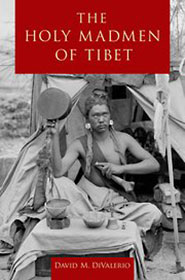
The Holy Madmen of Tibet, by David DiValerio, examines the lives and legacies of the three most famous “holy madmen,” certain Tibetan Buddhist yogins who have taken on profoundly norm-overturning modes of dress and behavior, including draping themselves in human remains, consuming filth, provoking others to violence, and even performing sacrilege. They became known far and wide as “madmen” (smyon pa, pronounced nyönpa), achieving a degree of saintliness in the process. This book offers the first comprehensive study of Tibet’s “holy madmen” drawing on their biographies and writings, as well as tantric commentaries, later histories, oral traditions, and more. By focusing on literature written by and about the “holy madmen” and on the yogins’ relationships with their public, this book offers in-depth looks at the narrative and social processes out of which sainthood arises, and at the role biographical literature can play in the formation of sectarian identities. By showing how understandings of the “madmen” have changed over time, this study allows for new insights into current notions of “crazy wisdom.” In the end, the “holy madmen” are seen as self-aware and purposeful individuals who were anything but insane. (Oxford University Press, 2015)
Holocaust Representations in History: An Introduction

Holocaust Representations in History: an Introduction, by Daniel H. Magilow and Lisa Silverman, is an introduction to critical questions and debates surrounding the depiction, chronicling and memorialization of the Holocaust through the historical analysis of some of the most provocative and significant works of Holocaust representation. In a series of chronologically presented case studies, the book introduces the major themes and issues of Holocaust representation across a variety of media and genres, including film, drama, literature, photography, visual art, television, graphic novels, and memorials. The case studies presented not only include well-known, commercially successful, and canonical works about the Holocaust, such as the film Shoah and Elie Wiesel’s memoir Night, but also controversial examples that have drawn accusations of profaning the memory of the genocide. Each work’s specific historical and cultural significance is then discussed to provide further insight into the impact of one of the most devastating events of the 20th century and the continued relevance of its memory. (Bloomsbury Publishing, 2015)
Elephant House
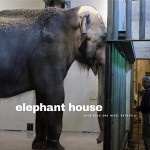
Elephant House, by Nigel Rothfels and Dick Blau, offers a thought-provoking study of the Oregon Zoo’s Asian Elephant Building and the daily routines of its residents—human and pachyderm alike. Looking at both the history of a building at the end of its use at the zoo and the animals and people who interact in it, Rothfels and Blau build a deeper understanding of this enigmatic environment, Elephant House is the result of a creative collaboration between a historian and a photographer and explores the relationships between captive elephants and their human caregivers. (Penn State University Press, 2015)
Bootstrap New Urbanism: Design, Race, and Redevelopment in Milwaukee

Bootstrap New Urbanism by Joseph Rodriguez critically examines the urban design and revitalization initiatives undertaken by both the government and the people of Milwaukee. In the 1990s, New Urbanists followed a city tradition of using urban design to solve problems while seeking to elevate the city’s national reputation and status. While New Urbanism was not the only design element undertaken to further Milwaukee’s redevelopment, the elite focus on New Urbanism reflected an attempt to fashion a self-help narrative for the revitalization of the city. This approach linked New Urbanist design to the strengthening of grassroots community organizing and volunteerism to solve urban problems. The book uncovers a practice with implications for urban history, architectural history, planning history, environmental design, ethnic studies, and urban politics. (Lexington Books, 2014)
Bibliography of Metropolitan Milwaukee

The Bibliography of Metropolitan Milwaukee by Ann M. Graf, Amanda Seligman and Margo Anderson provides a starting point for further research into the city and surrounding areas. It includes resources for Milwaukee, Ozaukee, Washington, and Waukesha counties. Subjects covered include places, biographies, race and ethnicity, politics, business, the economy, charity, religion, the arts, architecture, recreation, health, gender, the natural environment, media, infrastructure, bibliographies, and archives. Organized into 19 thematic chapters that are further organized by topic, this volume offers the most comprehensive bibliographical resources about the Milwaukee area ever produced. (Marquette University Press, 2014)
The United States of the United Races: A Utopian History of Racial Mixing

The United States of the United Races: A Utopian History of Racial Mixing by Greg Carter reconsiders an understudied optimist tradition in the history of racial amalgamation throughout U.S., one which has praised mixture as a means to create a new people, bring equality to all, and fulfill an American destiny. In this genealogy, Greg Carter re-envisions racial mixture as a vehicle for pride and a way for citizens to examine mixed America as a better America. Tracing the centuries-long conversation that began with Hector St. John de Crevecoeur’s Letters of an American Farmer in the 1780s through to the Mulitracial Movement of the 1990s and the debates surrounding racial categories on the U.S. Census in the twenty-first century, Greg Carter explores a broad range of documents and moments, unearthing a new narrative that locates hope in racial mixture. Carter traces the reception of the concept as it has evolved over the years, from and decade to decade and century to century, wherein even minor changes in individual attitudes have paved the way for major changes in public response. The United States of the United Races sweeps away an ugly element of U.S. history, replacing it with a new understanding of race in America. 2013. (NYU Press, 2013)
The German Minority in Interwar Poland
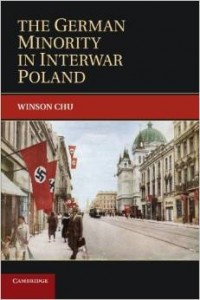
The German Minority in Interwar Poland by Winson Chu analyzes what happened when Germans from three different empires – the Russian, Habsburg, and German – were forced to live together in one, new state. After the First World War, German national activists made regional distinctions among these Germans and German-speakers in Poland, with preference initially for those who had once lived in the German Empire. Rather than becoming more cohesive over time, Poland’s ethnic Germans remained divided and did not unite within a single representative organization. Polish repressive policies and unequal subsidies from the German state exacerbated these differences, while National Socialism created new hierarchies and unleashed bitter intra-ethnic conflict among German minority leaders. Winson Chu challenges prevailing interpretations that German nationalism in the twentieth century viewed “Germans” as a homogeneous, single group of people. His revealing study shows that nationalist agitation could divide as well as unite an embattled ethnicity. (Cambridge University Press, 2012)
Becoming Austrians: Jews and Culture between the World Wars

Becoming Austrians: Jews and Culture between the World Wars, by Lisa Silverman, presents a unique, interdisciplinary examination of murder trials, literature, film, and theater. The book suggests a new approach to studying Jews and modern culture by using “Jewish difference” as a category of critical analysis, akin to “gender,” and is the first book in English to focus exclusively on Jews and Austrian culture between the World Wars. Oxford University Press, 2012.
Is Graduate School Really for You?: The Whos, Whats, Hows, and Whys of Pursuing a Master’s or Ph.D.
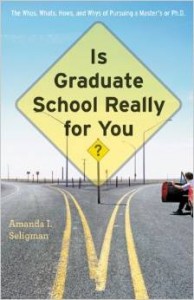
Is Graduate School Really for You?: The Whos, Whats, Hows, and Whys of Pursuing a Master’s or Ph.D. by Amanda Seligman helps potential students navigate graduate study—not just how to get in but how to succeed once you are there and what to expect when you leave. She weighs the pros and cons of attending graduate school against achieving a sustainable work-life balance and explains the application process, the culture of graduate school, and employment prospects for academics. This informed and candid book provides anyone thinking about pursuing an advanced degree—and those who support them—with the inside scoop on what to expect in graduate school. Written in a question-and-answer format, Is Graduate School Really for You? eliminates the guesswork. (Johns Hopkins University Press, 2012)
Encyclopedia of the U.S. Census: From the Constitution to the American Community Survey (ACS), 2d ed.

Encyclopedia of the U.S. Census: From the Constitution to the American Community Survey (ACS), 2d ed. edited by Margo J. Anderson, Constance F. Citro and Joseph J. Salvo, updates and expands a critically-acclaimed resource to the history, politics, content, procedures, and uses of the decennial census of the American population. The new edition highlights changes in the Census Bureau’s data collection and dissemination practices for the 2010 enumeration, including the use of a short-form questionnaire for the actual population count, and the release in late 2010 of the American Community Survey (ACS) 5-year data set based on rolling samples of the U.S. population and gathered using the long-form questionnaire. The second edition also comprehensively covers the fallout from the 2000 census and recent issues affecting the administration of the 2010 count. (CQ Press, 2011)
Hmong America: Reconstructing Community in Diaspora

Hmong America: Reconstructing Community in Diaspora by Chia Youyee Vang documents her own migration from Laos to Minnesota at age nine and the transformations she has witnessed in Hmong communities throughout the migration and settlement processes. Vang depicts Hmong experiences in Asia and examines aspects of community building in America to reveal how new Hmong identities have been formed and how they have challenged popular assumptions about race and ethnicity in multicultural America. With an approach that intermingles the archival research of a historian, the personal experiences of a refugee, and the participant-observer perspectives of a community insider, Vang constructs a nuanced and complex portrait of the more than 130,000 Hmong people who came to the United States as political refugees beginning in the mid-1970s. She offers critiques of previous representations of the Hmong community and provides the sociological underpinnings for a bold reassessment of Hmong history in the greater context of globalization. This new understanding redefines concepts of Hmong homogeneity and characterizes ordinary Hmong migrants not as passive victims but as dynamic actors who have exercised much power over their political and social destinies. While Vang focuses on the Hmong community in the Twin Cities, she also has conducted research in numerous Hmong enclaves in the United States and abroad. (University of Illinois Press, 2010)
Lost Letters of Medieval Life: English Society, 1200-1250

Lost Letters of Medieval Life: English Society, 1200-1250, edited by Martha Carlin and David Crouch, reveals everyday life in early thirteenth-century England in vivid detail through the correspondence of people from all classes, from peasants and shopkeepers to bishops and earls. The documents edited here include letters between masters and servants, husbands and wives, neighbors and enemies, and cover a wide range of topics: politics and war, going to fairs and going to law, attending tournaments and stocking a game park, borrowing cash and doing favors for friends, investigating adultery and building a windmill. While letters by celebrated people have long been known, the correspondence of ordinary people has not survived and has generally been assumed never to have existed in the first place. Martha Carlin and David Crouch, however, have discovered numerous examples of such correspondence hiding in plain sight. The letters can be found in manuscripts called formularies—the collections of form letters and other model documents that for centuries were used to teach the arts of letter-writing and keeping accounts. The editors present letters from two such manuscripts, here in their first printed edition, both in the original Latin and in English translation, with each document contextualized in an accompanying essay. (University of Pennsylvania Press, 2013)
Immigrant Rights in the Shadows of Citizenship

Immigrant Rights by Rachel Ida Buff brings prominent activists and scholars together to examine the emergence and significance of the contemporary immigrant rights movement. Contributors place the contemporary immigrant rights movement in historical and comparative contexts by looking at the ways immigrants and their allies have staked claims to rights in the past, and by examining movements based in different communities around the United States. Scholars explain the evolution of immigration policy, and analyze current conflicts around issues of immigrant rights; activists engaged in the current movement document the ways in which coalitions have been built among immigrants from different nations, and between immigrant and native born peoples. The essays examine the ways in which questions of immigrant rights engage broader issues of identity, including gender, race, and sexuality. (New York University Press, 2008)
Hmong in Minnesota

In Hmong in Minnesota, Chia Youyee Vang conveys how successive waves of Hmong, one of the most recent immigrant groups, have made their home in Minnesota. Vang reveals the colorful, intricate history of these immigrants, many of whom were forced to flee their homeland of Laos when the communists seized power during the Vietnam War. By introducing readers to the people themselves, the book tells the story of their struggle to adjust to new environments, build communities, maintain cultural practices, and make their mark on government policies and programs. (Minnesota Historical Society Press, 2008)
Surmounting the Barricades: Women in the Paris Commune
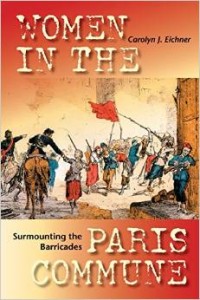
This book by Carolyn J. Eichner vividly evokes radical women’s integral roles within France’s revolutionary civil war known as the Paris Commune. It demonstrates the breadth, depth, and impact of communard feminist socialisms far beyond the 1871 insurrection. Examining the period from the early 1860s through that century’s end, Eichner investigates how radical women developed critiques of gender, class, and religious hierarchies in the immediate pre-Commune era, how these ideologies emerged as a plurality of feminist socialisms within the revolution, and how these varied politics subsequently affected fin-de-siècle gender and class relations. She focuses on three distinctly dissimilar revolutionary women leaders who exemplify multiple competing and complementary feminist socialisms: Andre Leo, Elisabeth Dmitrieff, and Paule Mink. Leo theorized and educated through journalism and fiction, Dmitrieff organized institutional power for working-class women, and Mink agitated crowds to create an egalitarian socialist world. Each woman forged her own path to gender equality and social justice. (Indiana University Press, 2004)
Savages and Beasts: The Birth of the Modern Zoo

Savages and Beasts, by Nigel Rothfels traces the origins of the modern zoo to the efforts of the German animal entrepreneur Carl Hagenbeck. By looking at Hagenbeck’s multiple enterprises, the book demonstrates how seemingly enlightened ideas about the role of zoos and the nature of animal captivity developed within the essentially tawdry business of placing exotic creatures on public display. Rothfels provides both fascinating reading and much-needed historical perspective on the nature of our relationship with the animal kingdom. (Johns Hopkins, 2002)
Representing Animals

Representing Animals, edited by Nigel Rothfels, explores the complex and often surprising connections between our imagining of animals and our cultural environment. The contributors—historians, literary critics, anthropologists, artists, art historians, and scholars of cultural studies—examine the ways we talk, write, photograph, imagine, and otherwise represent animals. The book includes topics such as pet cloning, fox hunting, animatronic characters, and how we displace our fear of aging onto our dogs. The book demonstrates the deep connections between the way we think about animals and the way we have thought about ourselves and our cultures in different times and places. Its publication marks a formative moment in the emerging field of animal studies. (Indiana UP, 2002)
The Nature of the Path: Reading a West African Road

Marcus Filippello shows how a road running through the Lama Valley in Southeastern Benin has become a mnemonic device allowing residents to counter prevailing histories. Built by the French colonial government, the road serves as a site where the Ọhọri people narrate their changing relationship to the environment and assert their independence in the political milieus of colonial and postcolonial Africa. (University of Minnesota Press, 2017)
Books by Emeritus Faculty
Poland, the United States and the Stabilization of Europe, 1919-1933

Neal Pease’s book is the first full-length study of relations between Poland and the U.S. following World War I, as Poland turned to America to buttress its precarious position. Pease examines how Polish leaders of the 1920s sought to enlist U.S. political and financial support on behalf of their beleaguered state. Drawing on exhaustive archival research, Pease unravels the fascinating ties between these unlikely diplomatic partners. Winner of the J. Pilsudski Institute of America’s award for the best book on the modern history of Poland. (Oxford University Press, 1986)
Watch on the Right: Conservative Intellectuals in the Reagan Era

The ascendancy of conservatism in the last twenty years is an unprecedented episode in American intellectual and political history. In Watch on the Right, J. David Hoeveler gives us enlightening, often humorous, portraits of the key thinkers behind this “revolution.” As Hoeveler writes, “conservative thinkers hang their hats on many different racks,” and this book dramatizes for us the breadth of the conservative coalition as exemplified by the eight writers surveyed: William F. Buckley, Jr., George Will, Robert Nisbet, Irving Kristol, Hilton Kramer, Jeanne Kirkpatrick, R. Emmett Tyrrell, Jr., and Michael Novak. Winner of the 1992 Council for Wisconsin Writers Award for Best Scholarly Book. (University of Wisconsin Press., 1991)
On Wisconsin Women: Working for Their Rights from Settlement to Suffrage

In On Wisconsin Women, Genevieve McBride traces women’s work in reform movements in the state’s politics and in its press. Among women who would be heard were Mathilde Fransziska Anneke, Emma Brown, Lavinia Goodell, Emma Bascom, Olympia Brown, Belle Case La Follette, Ada L. James, and Theodora Winton Youmans. McBride brings their voices vividly to life, in their own words on their lifelong work for woman’s rights. Winner of the 1995 Council for Wisconsin Writers Award for Best Scholarly Book and the 1994 State Historical Society of Wisconsin Book Award of Merit. (University of Wisconsin Press, 1995)
Taking the Train: How Graffiti Art Became an Urban Crisis in New York City
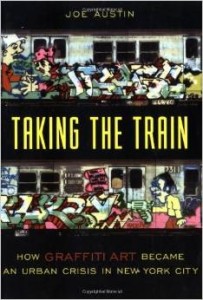
Joe Austin’s Taking the Train traces the history of “writing” in NYC and the struggle that developed between the city and the writers. Austin tracks how “writing” assumed crisis-level importance inside the NYC mayoral administrations and the Metropolitan Transportation Authority for almost two decades. Although the city took back the trains, Austin shows how and why the culture of “writing” became an art movement and a vital part of hip-hop culture. 2001. (Columbia University Press, 2001)
Creating the American Mind: Intellect and Politics in the Colonial Colleges
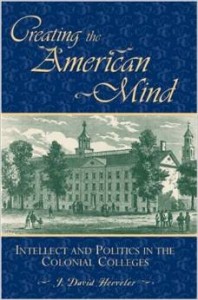
Creating the American Mind by J. David Hoeveler is the first book to present a synthetic treatment of the colonial colleges, tracing their role in the intellectual development of early Americans through the Revolution. Hoeveler focuses on Harvard, William and Mary, Yale, the College of New Jersey (Princeton), King’s College (Columbia), the College of Philadelphia (University of Pennsylvania), Queen’s College (Rutgers), the College of Rhode Island (Brown), and Dartmouth. (Rowman and Littlefield, 2003)
Modernity in the Flesh: Medicine, Law, and Society in Turn-of-the-Century Argentina

Modernity in the Flesh by Kristin Ruggiero examines the lives of people caught in the dynamics of changing mores, rapid urbanization, and real public health issues in nineteenth-century Buenos Aires. The book shows the costs Argentines paid for the establishment of liberal democracy between 1880 and 1910. Modernity raised consciousness of the public good and a commitment to new sciences and a new set of priorities that asserted the precedence of health and security of the social whole. (Stanford University Press, 2004)
The Jewish Diaspora in Latin America and the Caribbean: Fragments of Memory
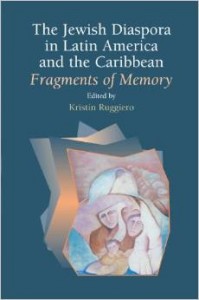
In The Jewish Diaspora in Latin America and the Caribbean editor Kristin Ruggiero assembled thirteen essays of the Jewish experience in Latin America, furthering the interdisciplinary exploration of four prominent themes in the history of the respective Jewries: memory, identity, anti-Semitism, and violence. These “fragments of memory” are a significant contribution to our understanding of Latin American Jewish life. (Sussex Academic Press, 2005)
The Postmodernist Turn: American Thought and Culture in the 1970s

During the 1970s, the United States became the world’s preeminent postindustrial society. This changed the way Americans lived and worked, and even altered their perceptions of reality. Americans struggled to find their place in a world where symbol became more important than fact, appearance more important than reality, where image supplanted essence. J. David Hoeveler finds that the sense of detachment and dislocation that characterizes the postindustrial society serves as a paradigm for American thought and culture in the 1970s. (Rowman and Littlefield, 2004)
Women’s Wisconsin: From Native Matriarchies to the New Millennium

Women’s Wisconsin: From Native Matriarchies to the New Millennium, by Genevieve G. McBride, is a new women’s history anthology that was published on Women’s Equality Day 2005. It will make history as the first single-source history of Wisconsin women. This unique tome features dozens of excerpts of articles as well as primary sources, such as women’s letters, reminiscences, and oral histories, previously published over many decades in the Wisconsin Magazine of History and other Society Press publications. Wisconsin Historical Society Press, 2005)
Rome’s Most Faithful Daughter: The Catholic Church and Independent Poland, 1914-1939

Neal Pease’s book states that when an independent Poland reappeared on the map of Europe after WW I, it was widely regarded as the most Catholic country on the continent. All the same, the relations of the Second Polish Republic with the Church — both its representatives inside the country and the Holy See itself — proved far more difficult than expected. (Ohio University Press, 2009)
The Marvelous Hairy Girls: The Gonzales Sisters and Their Worlds

The Marvelous Hairy Girls by Merry Wiesner-Hanks tells the extraordinary story of three sixteenth-century sisters who, along with their father and brothers, were afflicted with an extremely rare genetic condition that made them unusually hairy. Amazingly, the Gonzales sisters were welcomed in the courts of Europe, and spent much of their lives among nobles, musicians, and artists. Their double identity as humans and beasts made them intriguing subjects of medical investigations and of a considerable number of portraits, some of which still hang in European castles today. (Yale University Press, 2009)
Religious Transformations in the Early Modern World: A Brief Study with Documents

In the early modern period, for reasons that varied widely, leaders and thinkers from Mexico to the Ottoman Empire and from China to the Indian subcontinent sought to reform existing religions, develop new spiritual practices, promote innovative texts, and, on occasion, even create new religions. By presenting documents from different regions, and religious and philosophical traditions, including Islam, Judaism, Sikhism, Christianity, and Confucianism, Religious Transformations in the Early Modern World by Merry Wiesner-Hanks allows students to explore and analyze these varied transformations. (Bedford/St. Martin’s Books, 2009)
Early Modern Europe, 1450-1789

Early Modern Europe, 1450-1789 by Merry Wiesner-Hanks is the second edition of this best-selling textbook that covers European history from the invention of the printing press to the French Revolution, updated to include expanded coverage of the late eighteenth century and the Enlightenment, and to incorporate recent advances in gender history, global connections and cultural analysis. The text takes in Europe in its entirety, eastward to the Ottoman Empire, northward to Sweden, and southward to Portugal, and includes European colonies overseas. It integrates religious, gender, class, regional and ethnic differences as well as the economic, political, religious and cultural history of the period. The book sets developments in Europe in a global context, and features summaries, timelines, maps, illustrations, and discussion questions, along with interactive online resources. (Cambridge University Press, 2013)
The Cambridge World History

The Cambridge World History, for which Merry Wiesner-Hanks was the editor-in-chief, is an authoritative new nine-volume overview of the dynamic field of world history. It covers the whole of human history, not simply history since the development of written records, in an expanded time frame that represents the latest thinking in world and global history. With over two hundred essays, it is the most comprehensive account yet of the human past, and it draws on a broad international pool of leading academics from a wide range of scholarly disciplines. Reflecting the increasing awareness that world history can be examined through many different approaches and at varying geographic and chronological scales, each volume offers regional, topical, and comparative essays alongside case studies that provide depth of coverage to go with the breadth of vision that is the distinguishing characteristic of world history. (Cambridge University Press, 2015)
International Law and Japanese Sovereignty: The Emerging Global Order in the 19th Century

How does a nation become a great power? A global order was emerging in the nineteenth century, one in which all nations were included. This book explores the multiple legal grounds of Meiji Japan’s assertion of sovereign statehood within that order: natural law, treaty law, international administrative law, and the laws of war. Contrary to arguments that Japan was victimized by ‘unequal’ treaties, or that Japan was required to meet a ‘standard of civilization’ before it could participate in international society, Howland argues that the Westernizing Japanese state was a player from the start. In the midst of contradictions between law and imperialism, Japan expressed state will and legal acumen as an equal of the Western powers – international incidents in Japanese waters, disputes with foreign powers on Japanese territory, and the prosecution of interstate war. As a member of international administrative unions, Japan worked with fellow members to manage technical systems such as the telegraph and the post. As a member of organizations such as the International Law Association and as a leader at the Hague Peace Conferences, Japan helped to expand international law. By 1907, Japan was the first non-western state to join the ranks of the great powers. (Palgrave Macmillian, 2016)
Perspectives on Milwaukee’s Past

Perspectives on Milwaukee’s Past, edited by Margo Anderson and Victor Greene, offers a compelling case for the broader national significance of Milwaukee as a site of historical research. This book not only sheds light on Milwaukee’s history from its pre-industrial origins through the era of deindustrialization, but also surveys shifting historiographical trends in the scholarly and popular treatment of the city’s history. In this book, a diverse group of scholars explore key themes in Milwaukee’s history from settlement to the present. Contributors, who include History Department members Genevieve G. McBride, Aims McGuinness, and Joseph A. Rodriguez, discuss the importance of socialism and labor in local politics; Milwaukee’s ethnic diversity, including its unusually large and significant German American population; the function and origins of the city’s residential architecture; and the role of religious and ethnic culture in forming the city’s identity. Rich in detail, the essays also identify critical areas and methods for future investigations into Milwaukee’s past. (University of Illinois Press, 2009)
Generations of Youth: Youth Cultures and History in Twentieth Century America

Generations of Youth by Joe Austin & Michael N. Willard traces the central ways in which historical meanings and experiences of youth intersect with other axes of the U.S. social hierarchy. We learn how race, ethnicity, sexuality, gender, class, and space intersect to affect our notions of youth and youth’s notions of itself. (New York University Press, 1998)
The State of Sovereignty: Territories, Laws, Populations
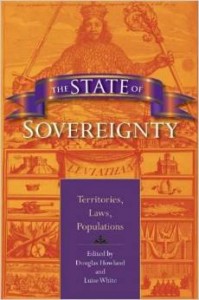
The State of Sovereignty: Territories, Laws, Populations was edited by Douglas Howland and Luise White, 2008. It examines how it came to pass that the nation-state became the prevailing form of governance in the world today. Spanning the 19th and 20th centuries and addressing colonization and decolonization around the globe, these essays argue that sovereignty is a set of historically contingent practices, and not something that accrues naturally to states. The contributors explore the different ways in which sovereign political forms have been defined and have defined themselves, placing recent debates about nations and national identity within a broader history of sovereignty, territory, and legality. (Indiana University Press, 2008)
Art and Sovereignty in Global Politics

Art and Sovereignty in Global Politics, edited by Douglas Howland, Elizabeth Lillehoj, and Maximilian Mayer, aims to question, challenge, supplement, and revise current understandings of the relationship between aesthetic and political operations. The authors transcend disciplinary boundaries and nurture a wide-ranging sensibility about art and sovereignty, two highly complex and interwoven dimensions of human experience that have rarely been explored by scholars in one conceptual space. Several chapters consider the intertwining of modern philosophical currents and modernist artistic forms, in particular those revealing formal abstraction, stylistic experimentation, self-conscious expression, and resistance to traditional definitions of “Art.” Other chapters deal with currents that emerged as facets of art became increasingly commercialized, merging with industrial design and popular entertainment industries. Some contributors address Post-Modernist art and theory, highlighting power relations and providing sceptical, critical commentary on repercussions of colonialism and notions of universal truths rooted in Western ideals. By interfering with established dichotomies and unsettling stable debates related to art and sovereignty, all contributors frame new perspectives on the co-constitution of artworks and practices of sovereignty. (Palgrave Macmillian, 2017)
John Bascom and the Origins of the Wisconsin Idea
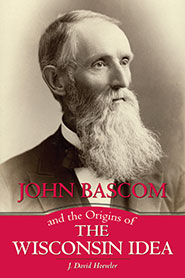
In the Progressive Era of American history, the state of Wisconsin gained national attention for its innovative economic and political reforms. Amidst this ferment, the “Wisconsin Idea” was popularized—the idea that a public university should improve the lives of people beyond the borders of its campus. Governor Robert La Follette routinely consulted with University of Wisconsin researchers to devise groundbreaking programs and legislation. Although the Wisconsin Idea is often attributed to a 1904 speech by Charles Van Hise, president of the University of Wisconsin, David Hoeveler argues that it originated decades earlier, in the creative and fertile mind of John Bascom. A philosopher, theologian, and sociologist, Bascom deeply influenced a generation of students at the University of Wisconsin, including La Follette and Van Hise. Hoeveler documents how Bascom drew concepts from German idealism, liberal Protestantism, and evolutionary theory, transforming them into advocacy for social and political reform. He was a champion of temperance, women’s rights, and labor, all of which brought him controversy as president of the university from 1874 to 1887. In a way unmatched by any leader of a major American university in his time, Bascom outlined a social gospel that called for an expanded role for state governments and universities as agencies of moral improvement. (University of Wisconsin Press, 2016)